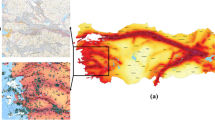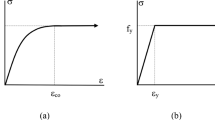Abstract
Based on advanced numerical simulation technologies, such as the birth and death of element technique, large displacement technique, and fluid-solid coupling mechanism, and combined with the strain rate effect of concrete and steel materials, a complicated finite element model of a TNT–air–slab system is set up using the nonlinear explicit dynamic finite element analysis software LS-DYNA. A series of numerical simulation analyses is conducted on the reinforced concrete slab to evaluate the properties of the blast shock wave at the back of the slab. First, the typical characteristics of the blast shock waves at the front and back of the slab are described concisely. Then, the relation between the incident wave and the reflected wave is built by further studying the influence of the slab on the properties of the reflected wave at the front of the slab. And then, the relation between the reflected wave and the reformed wave is established by analyzing the effect of the slab on the change law of the reformed wave at the back of the slab. Finally, the basic steps for predicting the properties of the reformed wave are given considering the effect of the reinforced concrete slab on it. In addition, the case study demonstrates that the predicted results are true and reliable, and it indicates that the proposed method can accurately and effectively predict the properties of the reformed wave at the back of the reinforced concrete slab.








Similar content being viewed by others
REFERENCES
R. Jayasooriya, D. P. Thambiratnam, N. J. Perera, and V. Kosse, “Blast and Residual Capacity Analysis of Reinforced Concrete Framed Buildings," Eng. Struct. 33 (12), 3483–3495 (2011).
B. M. Luccioni, R. D. Ambrosini, and R. F. Danesi, “Analysis of Building Collapse under Blast Loads," Eng. Struct.26 (1), 63–71 (2004).
Y. C. Shi, Z. X. Li, and H. Hao, “A New Method for Progressive Collapse Analysis of RC Frames under Blast Loading," Eng. Struct.32 (6), 1691–1703 (2010).
J. Henrych, The Dynamics of Explosion and Its Use, (Elsevier, Amsterdam–New York, 1979).
Technical Manual (TM-5-855-1). Fundamentals of Protective Design for Conventional Weapons (Headquarters, Department of the Army, Washington, 1986).
C. Q. Wu and H. Hao, “Modeling of Simultaneous Ground Shock and Airblast Pressure on Nearby Structures from Surface Explosions," Int. J. Impact Eng. 31 (6), 699–717 (2005).
O. Ram, E. Nof, and O. Sadot, “Dependence of the Blast Load Penetrating into a Structure on Initial Conditions and Internal Geometry," Exp. Therm. Fluid Sci. 78, 65–74 (2016).
C. Fouchier, D. Laboureur, L. Youinou, et al., “Experimental Investigation of Blast Wave Propagation in an Urban Environment," J. Loss Prev. Process Ind. 49 (pt B), 248–265 (2017).
T. A. Rose and P. D. Smith, “Influence of the Principal Geometrical Parameters of Straight City Streets on Positive and Negative Phase Blast Wave Impulses," Int. J. Impact Eng. 27 (4), 359–376 (2002).
A. M. Remennikov and T. A. Rose, “Modelling Blast Loads on Buildings in Complex City Geometries," Comput. Struct.83 (27), 2197–2205 (2005).
I. E. Edri, V. R. Feldgun, Yu. S. Karinski, and D. Z. Yankelevsky, “The Blast Load Acting on a Structure in an Internal Explosion Scenario," in Blast, Impact Loading, and Response; and Research and Education, ASCE Structures Congress 2018, pp. 362–375.
X. N. Gao, S. P. Wang, and Y. Jiang, “Shock Wave Pressure Distribution on Large-Space Structures and Explosion Venting under Blast Loading," Eng. Mech. 27 (4), 226–233 (2010).
T. B. Ma, X. Z. Xu, and J. G. Ning, “Research on Propagation Laws of Explosion Shock Wave Inside Metro Station," J Loss Prev. Process Ind. 46, 54–68 (2017).
O. Pennetier, M. William-Louis, and A. Langlet, “Numerical and Reduced-Scale Experimental Investigation of Blast Wave Shape in Underground Transportation Infrastructure," Proc. Saf. Env. Prot.94, 96–104 (2015).
Y. C. Shi, H. Hao, and Z. X. Li, “Numerical Simulation of Blast Wave Interaction with Structure Columns," Shock Waves17 (1), 113–133 (2007).
B. Zhang, X. Z. Nian, F. N. Jin, et al., “Failure Analyses of Flexible Ultra-High Molecular Weight Polyethylene (UHMWPE) Fiber Reinforced Anti-Blast Wall under Explosion," Compos. Struct.18, 759–774 (2018).
T. J. Holmquist, G. R. Johnson, and W. H. Cook, “A Computational Constitutive Model for Concrete Subjected to Large Strains, High Strain Rates and High Pressures," in 14th Int. Symp. on Ballistics (1993), pp. 591–600.
LS-DYNA. Keyword User’s Manual, Volume I (Livermore Software Technology Corporation, Livermore, 2016).
G. R. Johnson and W. H. Cook, “A Constitutive Model and Data for Metals Subjected to Large Strains, High Strain Rates and High Temperatures," in Proc. of the 7th Int. Symp. on Ballistics (1983), pp. 541–547.
LS-DYNA. Theory Manual (Livermore Software Technology Corporation, Livermore, 2016).
A. Schenker, I. Anteby, E. Gal, et al., “Full-Scale Field Tests of Concrete Slabs Subjected to Blast Loads," Int. J. Impact Eng.35 (3), 184–198 (2008).
L. P. Orlenko, Physics of Explosion (Fizmatlit, Moscow, 2002) [in Russian].
K. J. Huang, D. G. Zollinger, X. J. Shi, and P. Z. Sun, “A Developed Method of Analyzing Temperature and Moisture Profiles in Rigid Pavement Slabs," Constr. Build. Mater. 151, 782–788 (2017).
Eurocode 2. Design of Concrete Structures (Civil Engineering, 2003).
W. J. Wang and N. Chouw, “Experimental and Theoretical Studies of Flax FRP Strengthened Coconut Fibre Reinforced Concrete Slabs under Impact Loadings," Constr. Build. Mater. 171, 546–557 (2018).
H. Sadraie, A. Khaloo, and H. Soltani, “Dynamic Performance of Concrete Slabs Reinforced with Steel and GFRP Bars under Impact Loading," Eng. Struct. 191, 62–81 (2019).
Unified Facilities Criteria (UFC). Design of Buildings to Resist Progressive Collapse (Department of Defense, 2013).
Y. C. Shi, H. Hao, and Z. X. Li, “Numerical Derivation of Pressure–Impulse Diagrams for Prediction of RC Column Damage to Blast Loads," Int. J. Impact Eng. 35 (11), 1213–1227 (2008).
K. Nakayama, T. Kakinuma, and H. Tsuji, “Oblique Reflection of Large Internal Solitary Waves in a Two-Layer Fluid," Eur. J. Mech. B/Fluids 74, 81–91 (2019).
W. B. Wu, A.-M. Zhang, Y. L. Liu, and S.-P. Wang, “Local Discontinuous Galerkin Method for Far-Field Underwater Explosion Shock Wave and Cavitation," Appl. Ocean Res. 87, 102–110 (2019).
Author information
Authors and Affiliations
Corresponding author
Rights and permissions
About this article
Cite this article
Lin, SC., Gao, S. & Han, JQ. Effect of the Reinforced Concrete Slab on the Blast Shock Wave Properties. Combust Explos Shock Waves 56, 731–740 (2020). https://doi.org/10.1134/S0010508220060131
Received:
Published:
Issue Date:
DOI: https://doi.org/10.1134/S0010508220060131




